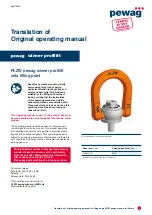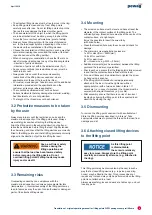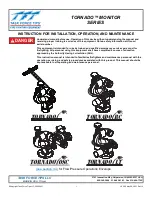
April 2019
3
Translation of original operating manual for lifting points PLZW pewag winner profilift zeta
Other information:
The lifting point may only be mounted
with original parts. The ring is 360° rotatable around the
screw and must be aligned with the expected direction of pull
prior to loading.
This product has a safety factor of 5.
For exact dimensions, refer to our website at www.pewag.com
2.1 Restrictions on use
• These lifting points are not suitable for use in areas with
strong corrosive influences (e.g. in the vicinity of sewage
water or chemicals). Lifting points must not be exposed
to acids or caustic solutions and their vapours. For use in
environments containing chemicals, please consult our
technical service.
• The lifting points are not suitable for edge- or corner-
loading.
• Do not use this product for the lifting or securing of
persons.
• Do not use lifting points as a choke-hitch.
• For the load capacities of pewag lifting chains to apply, it is
assumed that the individual lifting points are placed under
load symmetrically. When the load is lifted, this will result in
the same angles of inclination of the individual chain legs.
• In case of asymmetrical loads, you must take into account
the following:
1. The load is less than 80% of the indicated load capacity.
2. The angles of inclination of all chain strands are not
lower than 15° and are very similar (i.e. only differ by a
maximum of 5°).
3. For three- and four-stranded lifting chains, it must be
ensured that the corresponding plan angles are within 15°
of each other. If any of these conditions are not met, only
one strand may be considered load-bearing
(see load capacity table).
• The lifting points may not be rotated while under load.
• The ring may not be folded up and down continuously
while under load.
The information
contained in this
operating manual is
based on the assumption that no particularly
hazardous conditions apply.
Such conditions include offshore use and use in
areas with nuclear contamination.
In such cases, please contact pewag to determine
the permissibility of the application and the
degree of danger.
2.2 Foreseeable misuse
• Use by improperly trained personnel.
• Use by personnel who is unable to fully comprehend the
language of this operating manual.
• Attachment to components for which no operating manual
or proof of strength exists.
• Attachment of inappropriate lifting devices.
• Attachment of lifting devices for which no operating manual or
inspection report according to currently valid standards exists.
2.3 Labelling and identification
Every pewag lifting point is labelled with its maximum load
capacity for adverse loading conditions as well as the
manufacturer’s code and batch number. The following image
shows the part number and the precise identification details
on the product.
Fig. 3: Part number and location of the identification details on the product.
3. Assembly instructions
3.1 General information
• This product may only be assembled by persons who
were instructed in the safe use of the product and have the
required knowledge and skills.
• Only original pewag parts may be used.
– These are recognisable from the stamp (batch number,
manufacturer logo or code PW...)
• Only mount lifting points that are free from defects.
• Used lifting points must be inspected prior to each use as
specified by the maintenance instructions.
• Check that the lifting point has been attached according to
the assembly instructions during each use.
• Attach lifting points in such a way that they may be reached
easily and without obstruction when attaching or removing
the connecting element. Check that no hazardous points
are created that could endanger the user or impede correct
usage (risk of crushing, pinching or collision).


























